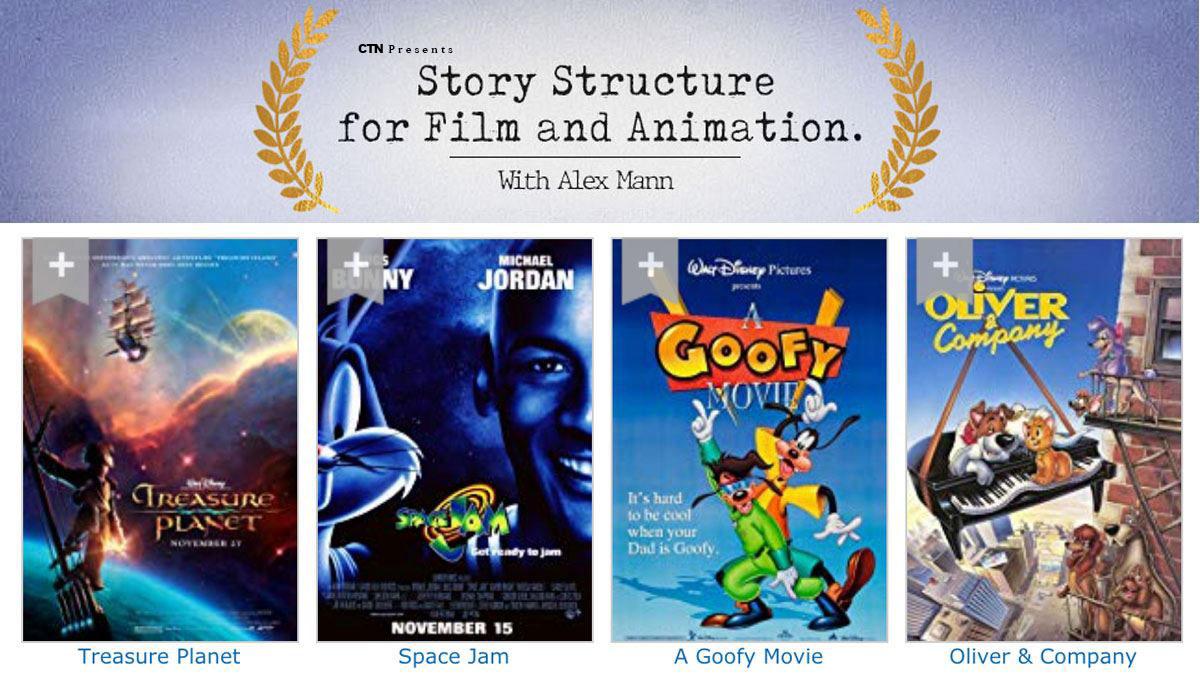 Sell tickets and manage registrations
Sell tickets and manage registrations
 View my tickets and registrations
View my tickets and registrations
 Sell more tickets through digital marketing
Sell more tickets through digital marketing
 Add an event calendar to your website
Add an event calendar to your website
 Find events by location and categories
Find events by location and categories
Story Structure for Film and Animation

Born and raised in Southern California, ALEX MANN is the son of actress Mary Kathleen Williams-Mann and award-winning Hollywood film director Daniel Mann. He attended the Windward School in Santa Monica, CA. Upon graduating high school, Alex was a summer intern at The Walt Disney Studios where he worked with many brilliant Disney veterans during the production of The Rescuers.
Alex attended film school at California Institute of the Arts after being awarded a Disney Fellowship. He studied character animation and screenwriting under the tutelage of animation director Jack Hannah, and legendary British filmmaker Alexander “Sandy” Mackendrick. After receiving his BFA from Cal-Arts, he worked in story development for producer Robert Joseph at Universal Studios. Later, Alex was recruited by Hyperion Pictures to work on the award-winning animated feature The Brave Little Toaster.
The Walt Disney Studios hired Alex to co-write and co-direct, the Annie nominated, Mickey's Once Upon a Christmas. In addition, he worked on early story development for Disney’s Frozen. Alex was instrumental in creating the final script for Mickey’s Philharmagic, a co-production between Disney Animation Studios and Walt Disney Imagineering. The project features 3D animation from many of Disney’s classic animated movies, notably: Beauty and the Beast, The Little Mermaid, The Lion King, Aladdin and Peter Pan. The attraction is a resounding success with audiences at Disney Park’s around the world.
Over the years, Alex has had the pleasure of working as a writer, director and story artist for Sony Pictures Animation, Warner Brothers, Walt Disney Animation Studios, Disney Imagineering, Universal Studios, and Nickelodeon on many popular animated movies and television shows - highlights include: The Goofy Movie, Oliver and Co., Space Jam, Lilo and Stitch 2, Treasure Planet, Curious George, Tinker Bell, and Planes. Currently Alex is teaching dramatic construction and film grammar to character animation students in the Entertainment Design School at Art Center College of Design. In addition to his membership in The Animation Guild, Alex is a member of The Writers Guild of America.
Alex Mann, veteran storyteller from Walt Disney Feature Animation and Nickelodeon (to name only a few), will teach you to turn your good ideas into great stories.
For a fraction of the cost you can enroll in the same story intensive master class taught by Alex Mann at Art Center without spending the cost of college tuition.
Limited seating to enhance learning.
Sign up NOW for this intensive workshop held at CTNstudio in the animation and film capital of the world Burbank CA
April 9, 2020 - June 11, 2020
6pm - 10pm
A 10 week seminar
CTN STUDIO
847 N. Hollywood Way, Suite 100
Burbank, CA 91505
(818) 859 0269 M-F 11-6
The workshop is designed for animation and live-action storytellers who want to discover techniques that filmmakers use to generate emotionally charged well-structured stories. In this class, our primary objective is to learn how to use the principles of classic narrative structure to create a visceral symbiotic engagement with our audience through a great story, well told. We will be taking an in-depth look at dramatic construction fundamentals – highlights include: three-act structure, point of attack, character development, moral dilemma, dramatic irony, sub-text and theme. We will, analyze why story values properly dramatized are the key to understanding theme, and gives stories meaning. In addition, we will uncover the eight essential questions every successful narrative must ask. Participants will be called upon to generate an original beat sheet, story outline and treatment for a short film. Collectively, we’ll workshop the stories and students will receive in-class critiques.
Week 01 What is a Story?
Introductory overview. Why society needs stories. Anatomy of a story. A few thoughts on Aristotle’s Poetics - Unity of Action, etc. Overview of classical narrative structure. David Manet on drama. Intention and Obstacle. Gaining an understanding to your characters “flaw.” Why the essence of drama is conflict and tension. Story or Plot what is the difference? Core story structure for short-form. Desire, Surrender, Transformation. Four types of conflict. Genre. Story patterns.
We will screen 3 Oscar winning CG short films: Pixar’s Piper (2016), Disney’s Paperman (2012), and Passion Pictures Australia The Lost Thing (2010).
Followed by in-depth analysis.
Week 02 Character Analysis, Three-Act Structure, Theme.
What is a Protagonist/Antagonist. Characterization vs. Character-in-Action. Define story terms and create a thorough foundational analysis of three-act structure and how it impacts character development, theme. Show, then Tell. How structure creates a multilayered story and characters. The MacGuffin. The eight essential questions. Why drama is Anticipation Mingled with Uncertainty. Loglines, story summary, beat sheets, step-outlines, treatments, scripts. storyboards, animatics.
Screen: On the Waterfront. Followed up with story structure, character development cross analysis between the three–act structure lecture and the screened movie. Concluding with how Theme is built from inciting incident to climax of the story – an organic process, that is the very DNA of great storytelling.
Week 03 Character Arcs, Backstory, Subtext.
Creating believable characters – dominate traits, plus we will discuss quirks and eccentricities. The inner story - discovering your protagonists “wound.” What is the story behind the story? Character as personification of theme. Understand the importance of creating a heartfelt backstory. Orchestrating a character arc throughout three acts. – Desire, Journey and Transformation – revised. Sub-text explored. Fundamental truths for the storyteller.
Analysis on Theme/Story/Character Arc – Toy Story 2.
Week 04 Scene Structure, Spine, Super Objective. Dramatic Irony.
Anatomy of a scene. Turning points. Value changes within a scene. Defining the stakes within a scene? Who drives the scene? Turning abstract ideas into playable behavior. Every scene needs a question. Enter early, Exit late. Setups and Pay-offs. Temporal dimensions of film - Acts, Sequences, Scene, Beats. More on story values. Will Suspension of Disbelief. Dramatic Irony.
Screen clip: Disney’s animated Mulan, Dustin Hoffman Tootsie. (Classic examples of dramatic irony.)
Week 05 Focus on Act I Turning Points, Sub-plots.
Restating the Central Dramatic Question. Raising the stakes. Reversals. External obstacles generate internal conflict. Unpacking the sub-plot. Setting up the 3 Stakes. Activity vs, action.
Using storytelling tools. Generating Ideas, Lateral Thinking. Building original ideas, loglines, story summary, beat sheets, step-outlines.
Screen clip: On the Waterfront. First Act Turning point.
Week 06 The Mid-Point (Point of No Return), Pitching.
The heart of the story. Metanoia – Self-reflection and facing the death of our protagonist’s belief system. Moral dilemma and values. Looking at the mid-point from a subjective/objective viewpoint. Pitching original ideas. Workshopping. Loglines, character descriptions, story summary. Story cards.
Practice pitch : W. Somerset Maugham’s – “Appointment in Samarra.”
Screen clips : Moonstruck, Jaws, Up. Followed by Mid-Point analysis.
Week 07 Act II Turning Points. Opening Act III
Second act dramatic reversal. It appears as if the protagonist has run out of options. Abyss and Revelation, Downward Fall. The midnight of the soul moment. Coming into the full understanding of Metanoia – How this realization has earned us a right to enter Act three.
Story meeting: Pitching loglines, story cards, beat sheets.
Screen clips: Toy Story 2. Erin Brockovich.
Week 08 Third Acts and Powerful Endings.
Further analysis of the Obligatory scene, How Crisis Impacts Exterior, Interior Stakes and Theme. Apparent Defeat, The Decisive Moment, Climax, Resolution - Denouement.
Paying off the External. Internal, Philosophical Stakes. How meaning is derived in a story.
Screen clips: Act III from Little Miss Sunshine, The Graduate. Klaus, Toy Story 3.
Pitching first draft step-outlines.
Week 09 Rewriting.
Refining the treatment. Voice. Dialogue. Rhythm and flow. Does it play? Editing. Identify plot holes and flat characters. Story values revisited. Forces of antagonism. Visceral storytelling: or how to light up an audience’s brain. Work in Progress, Pitching. Critique.
Week 10 Wrap-Up. Closing Thoughts.
Concluding observations about narrative storytelling. Continuing the study of narrative communication. The immutable truth of Dramaturgy.
Reading of treatments. Final critique.
Putting it all together: Screening Erin Brockovich.

